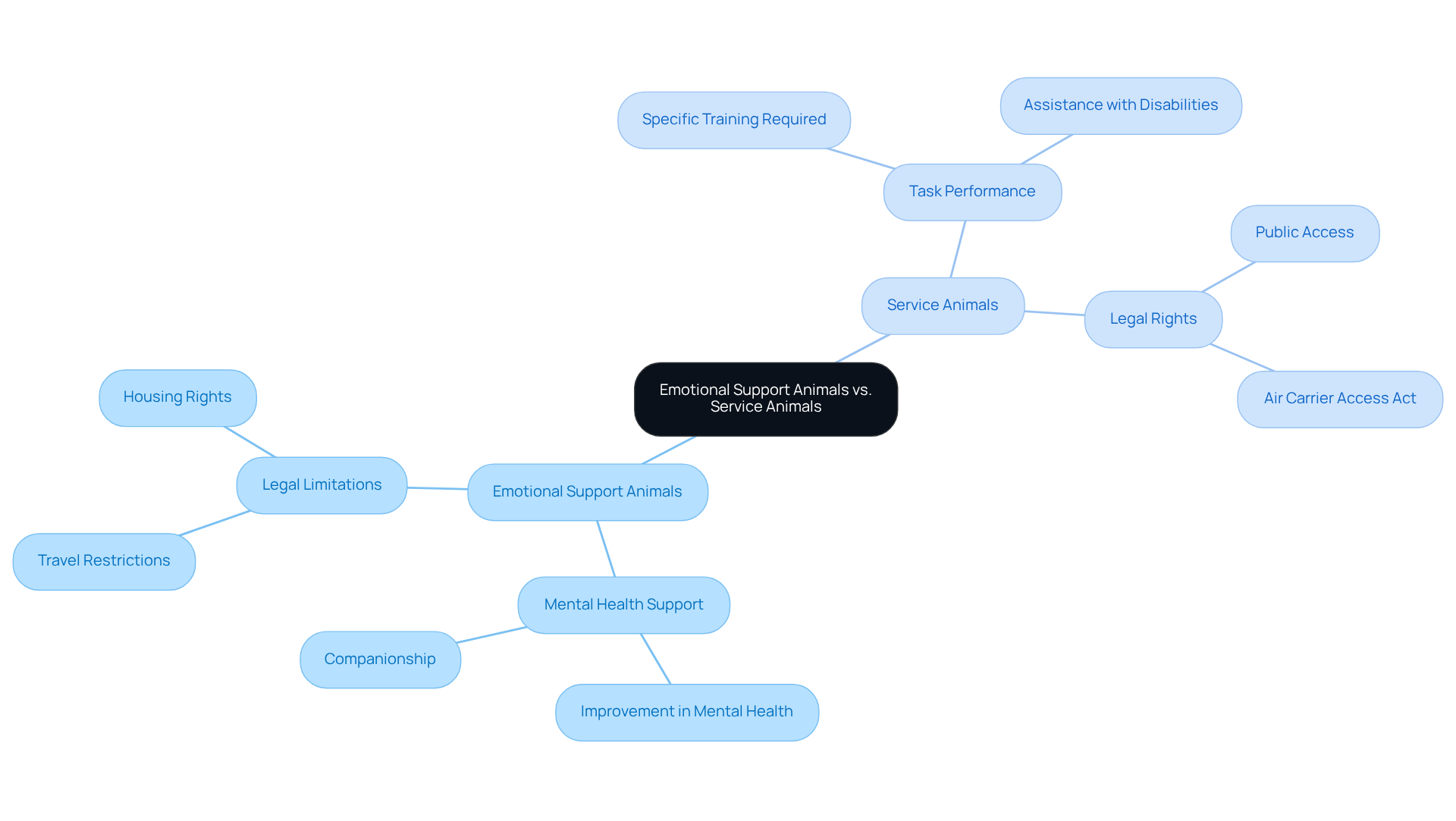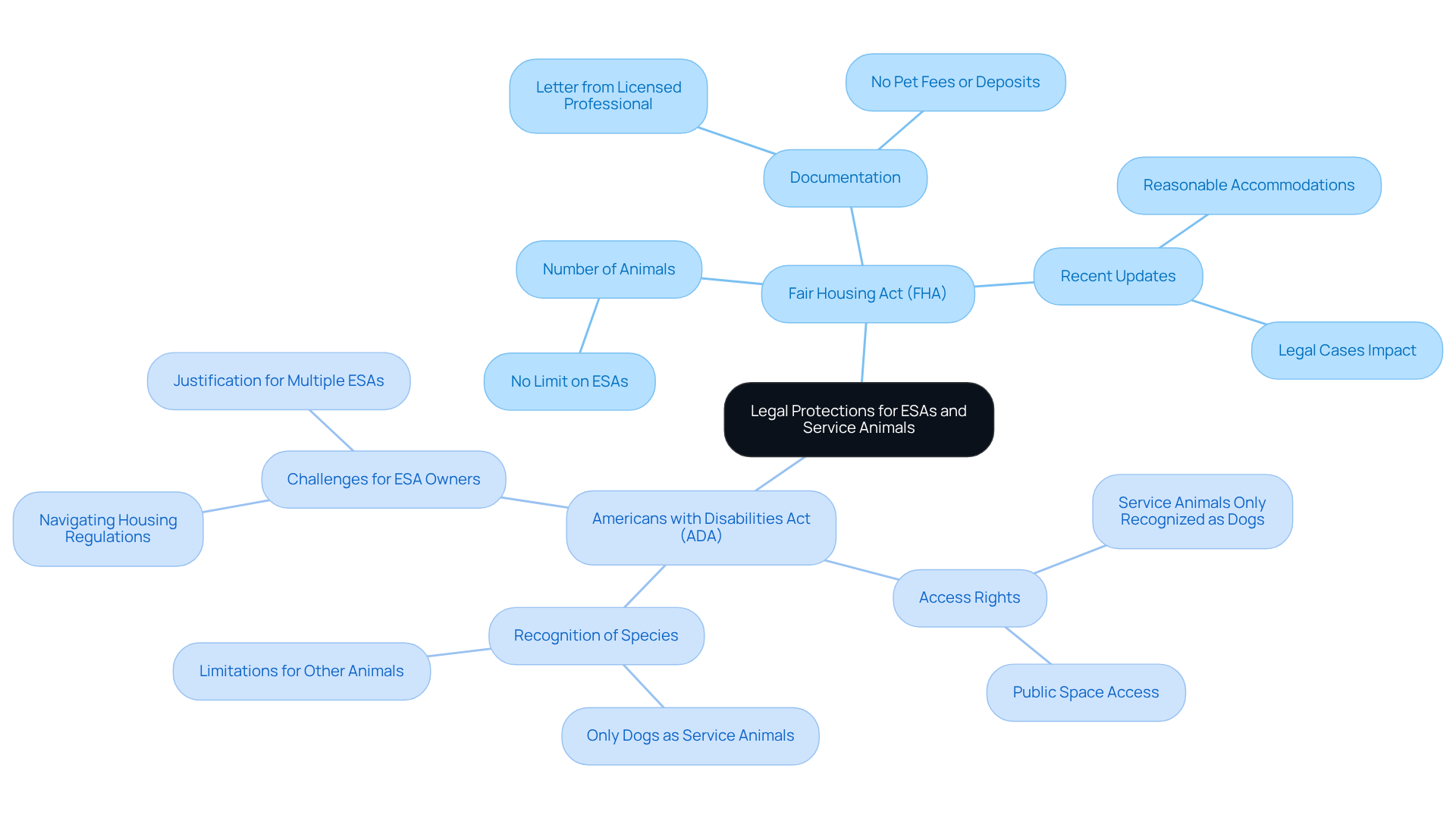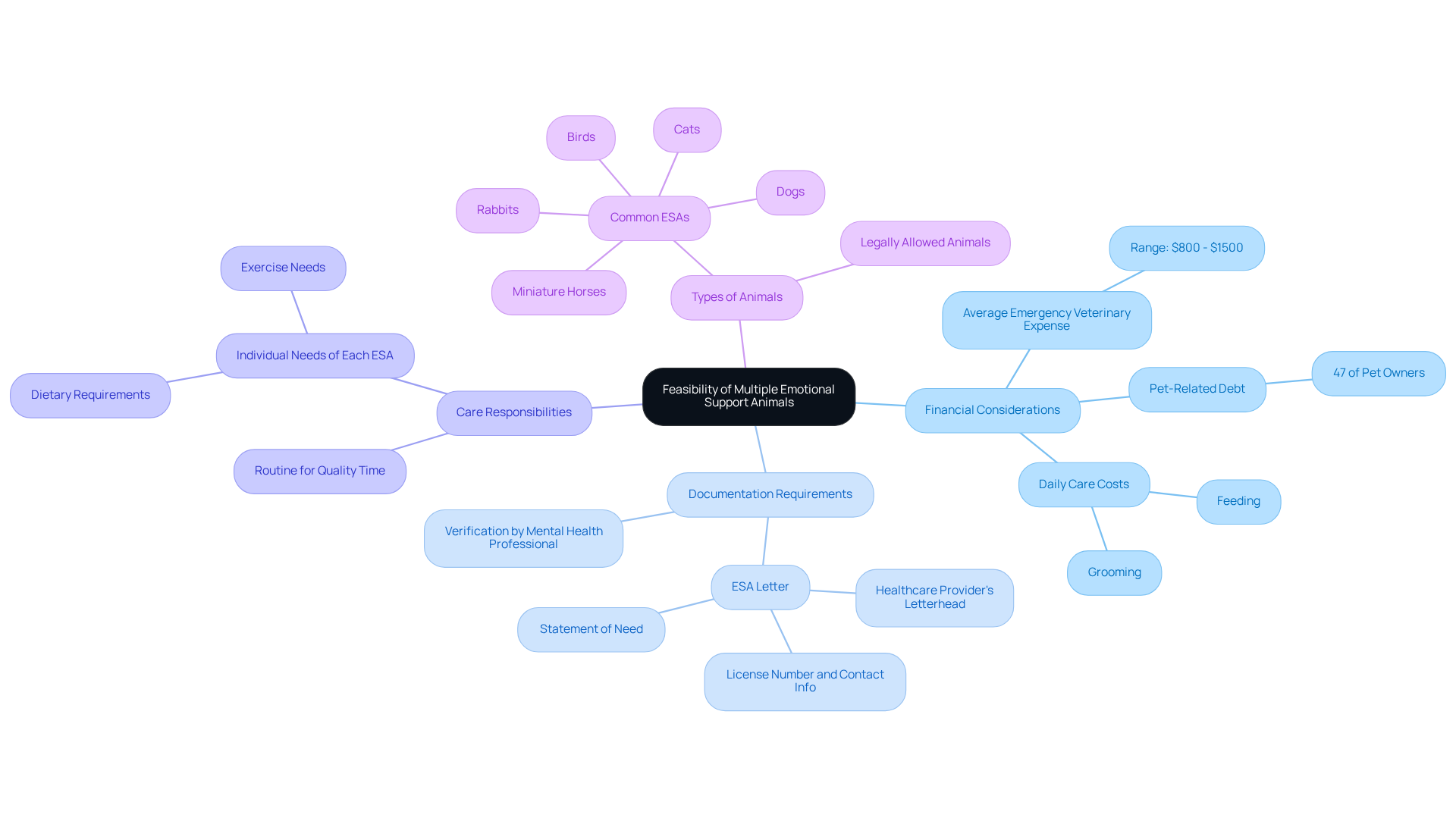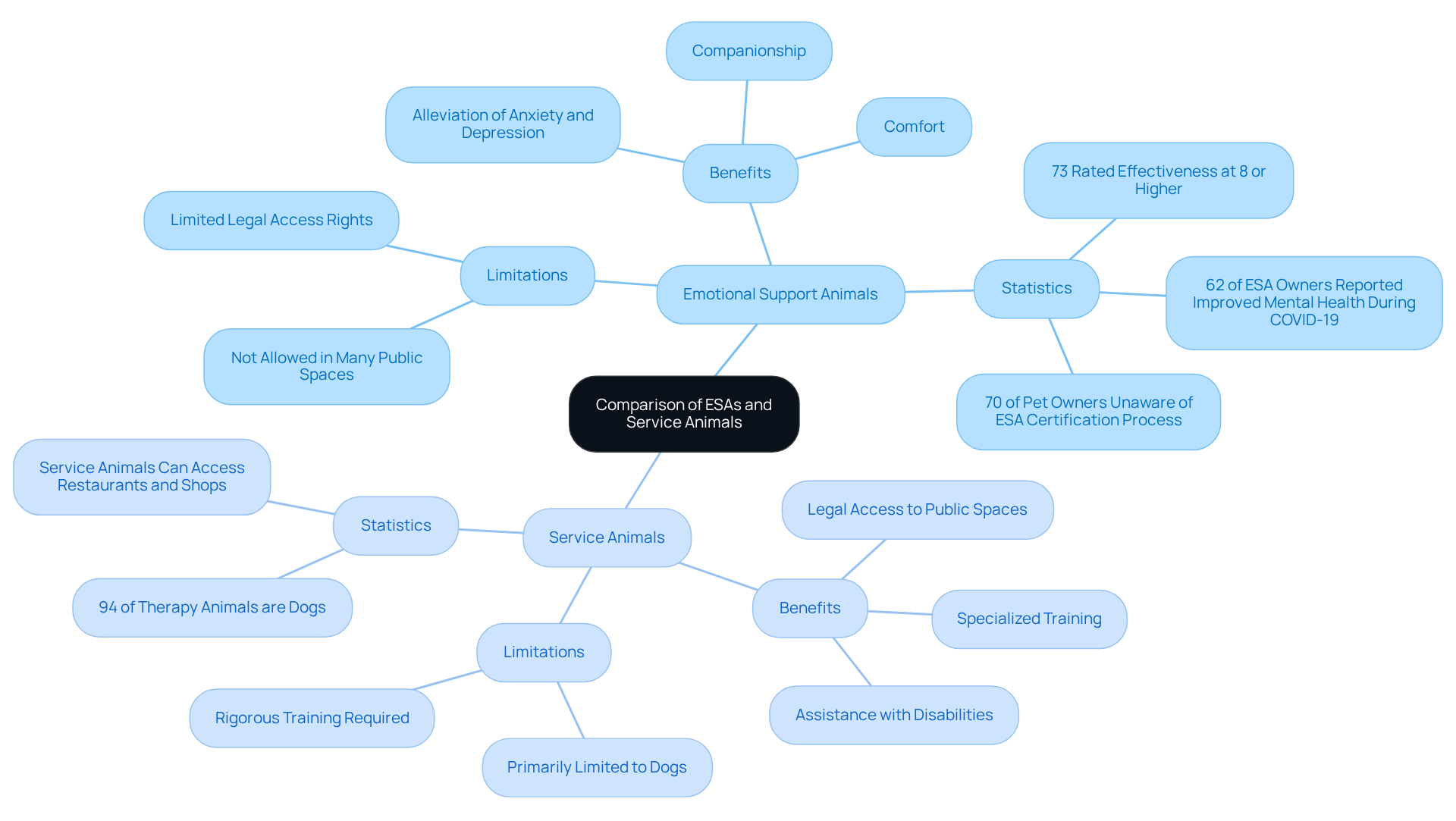

Can You Have 2 Emotional Support Animals? Key Considerations
by Lena Park
Last updated: August 15, 2025
Verified and Approved by:
Angela Morris,
MSW, LCSW
Fact Checked

Overview
You can have two emotional support animals, as the Fair Housing Act does not impose a limit on the number of emotional support animals a person can have, provided they have the necessary documentation from a licensed mental health professional for each pet.
While emotional support animals offer significant emotional benefits and companionship, it’s important for owners to consider the financial and practical factors involved in caring for multiple pets.
Reflect on whether you can meet the needs of all your animals effectively, ensuring that each pet receives the love and attention they deserve.
Remember, the journey of caring for emotional support animals can be incredibly rewarding, and it’s essential to approach it with both heart and practicality.
Introduction
Navigating the complexities of emotional support animals (ESAs) and their legal implications can be a daunting experience for those seeking companionship and solace. With nearly 18% of pet owners in the U.S. relying on these cherished companions to help alleviate mental health challenges, a pressing question emerges: is it possible to have multiple emotional support animals?
This article explores the numerous benefits, potential limitations, and legal considerations of owning two or more ESAs, offering vital insights for individuals eager to enhance their emotional well-being. As you contemplate the feasibility of such a decision, you may find yourself reflecting on the challenges and requirements involved—what truly defines the need for multiple sources of support?
Your journey towards emotional support is important, and understanding these nuances can pave the way for a more fulfilling experience.
Define Emotional Support Animals and Service Animals
Emotional Support Creatures play a crucial role in providing comfort and assistance to individuals grappling with mental health challenges such as anxiety, depression, and PTSD. These beloved pets offer companionship and emotional stability, distinguishing them from support creatures, which are specially trained dogs recognized under the Americans with Disabilities Act (ADA) to perform specific tasks for individuals with disabilities. This distinction is important, as it influences the legal rights and access that each category of creature has in public spaces and housing situations. For example, while Service Animals are permitted in all public areas, emotional support animals may face certain limitations, particularly in travel and housing contexts.
Recent surveys indicate that approximately 18% of pet owners in the U.S. have emotional support companions, with many reporting significant improvements in their mental health due to the companionship these creatures provide. Interactions with emotional support animals can trigger the release of ‘feel-good’ chemicals, enhancing mood and fostering emotional balance. Understanding these distinctions is vital for those considering the benefits of having multiple support creatures, especially when asking, can you have 2 emotional support animals, as requests for additional assistance companions must be substantiated by documentation from licensed healthcare professionals.
Wellness Wag is dedicated to simplifying the process of obtaining ESA letters, ensuring that clients can easily navigate the necessary requirements. They also offer affordable payment plans and financing options, making it easier for clients to manage costs. With a Money-Back Guarantee and positive client testimonials, Wellness Wag reinforces its commitment to enhancing mental well-being through emotional support animals. As Christian Diaz insightfully notes, ‘The main distinction between service creatures and emotional support creatures is the kind of assistance they offer.’ This understanding can empower individuals to seek the support they need, fostering a sense of connection and hope.

Explore Legal Protections for ESAs and Service Animals
Under the Fair Housing Act (FHA), individuals with Emotional Support Animals (ESAs) are granted the opportunity to live with their companions in residences that typically prohibit pets, provided they possess the necessary documentation from a licensed mental health professional. This provision is particularly significant, as the FHA does not limit the number of emotional support animals a person can have, raising the question of can you have 2 emotional support animals, which allows for multiple sources of emotional comfort that may be essential for their mental well-being. Imagine the relief for those who rely on various companions for support.
In contrast, Service Animals, as defined by the Americans with Disabilities Act (ADA), enjoy broader access rights, enabling them to accompany their handlers in nearly all public spaces. However, it’s important to note that the ADA recognizes only dogs as Service Animals, which can feel limiting for those who benefit from the presence of other types of emotional support creatures. This distinction can create challenges for individuals who may need to ask, can you have 2 emotional support animals, as they navigate housing regulations and must provide adequate justification for each pet’s necessity.
Recent updates to the FHA highlight the importance of reasonable accommodations for tenants with emotional support animals, reinforcing that landlords cannot impose pet fees or deposits for these beloved companions. As legal cases continue to evolve, they shape the landscape of housing rights for ESA owners, underscoring the ongoing need for awareness and compliance with these changing regulations. Have you ever felt overwhelmed by the complexities of these rights? It’s crucial to understand them fully.
Expert insights suggest that grasping these legal rights is essential for individuals aiming to advocate for their needs effectively. This understanding can help ensure that their emotional support requirements are met without unnecessary obstacles, allowing them to focus on their well-being and the comfort their ESAs provide. Remember, you are not alone in this journey—support is available, and there are compassionate solutions to help you navigate these challenges.

Assess the Feasibility of Having Multiple Emotional Support Animals
When considering if you can have 2 emotional support animals, it’s important to assess various factors, including financial considerations, to determine if owning multiple Emotional Support Animals is a feasible choice. Each ESA must be justified by a licensed mental health expert, who will provide documentation outlining the necessity of each pet for the person’s mental well-being. This documentation should include the healthcare provider’s official letterhead, license number, contact information, and a statement affirming that the individual’s symptoms are alleviated by the companionship of the ESAs.
Along with documentation, owners must consider their living environment and the financial implications of caring for multiple pets. With 47% of pet owners facing pet-related debt and the average emergency veterinary expense varying from $800 to $1500, it is crucial to evaluate if one can handle these possible costs alongside daily care, feeding, grooming, and ensuring that each pet is well-behaved and receives sufficient attention.
Challenges can occur, especially for individuals with intricate mental health requirements who wonder, can you have 2 emotional support animals to gain from their company. Mental health professionals often recognize that when considering emotional support, many ask, can you have 2 emotional support animals to provide additional emotional support, especially for those dealing with conditions like anxiety, depression, or PTSD. However, it is essential for owners to evaluate their ability to offer the necessary care and support for each pet, ensuring that they can meet the emotional and physical requirements of all their emotional support companions effectively.
Furthermore, it is essential to recognize that different kinds of creatures can qualify as emotional support animals, including dogs, cats, rabbits, birds, and miniature horses. While it is legally allowable to have several emotional support animals, people must consider their personal situations and resources, including the financial aspects of caring for numerous pets, to determine if can you have 2 emotional support animals and ensure a harmonious living environment for both themselves and their animals.
As you consider these factors, reflect on your pets. What’s your pet’s name?

Compare Benefits and Limitations of ESAs and Service Animals
Emotional Support Creatures provide significant emotional benefits, such as companionship and comfort, which can greatly alleviate feelings of anxiety, depression, and loneliness. Unlike assistance creatures, emotional support animals encompass a broader range of species, including cats, rabbits, and birds, making them more accessible for those in need of emotional support. However, it’s important to note that emotional support creatures do not possess the same legal access rights as service creatures, which can limit their presence in public spaces. For instance, while Service Creatures are permitted in restaurants and shops due to their specialized training to assist individuals with disabilities, Emotional Support Animals may be denied entry in many locations.
Understanding the distinction between emotional support creatures and service animals is crucial for those considering their options. Service Animals, primarily dogs, undergo rigorous training to perform specific tasks that assist their handlers, such as guiding individuals with visual impairments or alerting those with hearing loss. This specialized training grants them access to a wider array of environments, a privilege not extended to emotional support animals.
Real-world examples underscore the emotional benefits of emotional support animals. A survey revealed that 62% of ESA owners experienced improvements in their mental health during the COVID-19 pandemic, compared to only 19% of those without an ESA. This statistic highlights the vital role emotional support animals can play in enhancing emotional well-being, particularly during challenging times.
Nevertheless, emotional support animals face challenges in public spaces. Many establishments are not legally required to allow emotional support animals, which can lead to frustration for owners seeking companionship in various settings. Experts suggest that while ESAs offer valuable emotional support, their lack of legal recognition compared to Service Animals can limit their effectiveness in certain situations. Additionally, while the Fair Housing Act and the Air Carrier Access Act afford specific rights for ESA owners, these rights do not apply to public spaces like restaurants and stores.
It’s also noteworthy that 70% of pet owners are unaware of how to get their pet certified as an ESA or mistakenly believe they do not qualify, creating a barrier to accessing these essential benefits. Wellness Wag provides a streamlined online process for obtaining ESA letters, ensuring an affordable and efficient experience. With interest-free payment plans starting at $32.25, individuals can navigate the registration process with ease. Client testimonials reflect the smooth experience of acquiring ESA letters through Wellness Wag, emphasizing satisfaction with the service. Additionally, the gender disparity among ESA owners is significant, with 71% being male. Ultimately, when considering whether you can have 2 emotional support animals or a Service Animal, the decision should be guided by the individual’s specific needs, living circumstances, and the type of support they require. For those in states like Arkansas, California, Iowa, Louisiana, and Montana, it’s essential to understand the specific guidelines that necessitate a client-provider relationship lasting at least 30 days before obtaining an ESA letter.

Conclusion
The possibility of having multiple emotional support animals (ESAs) opens a door to enhanced emotional well-being for those who may benefit from the companionship of more than one pet. While emotional support animals provide invaluable comfort and emotional stability, understanding the legal distinctions and requirements surrounding their ownership is crucial for individuals considering this option. The Fair Housing Act supports the presence of ESAs in residences, allowing for the possibility of having more than one, provided that proper documentation from a licensed mental health professional is obtained.
Have you ever felt the profound impact of companionship on your mental health? Key insights from the article highlight the differences between emotional support animals and service animals, particularly regarding their legal rights and access to public spaces. Emotional support animals can significantly improve mental health, as evidenced by surveys showing a notable increase in well-being among ESA owners. However, the limitations placed on ESAs in public settings can pose challenges for individuals seeking companionship outside the home. Furthermore, considerations such as financial implications and the ability to provide adequate care for multiple pets are essential in determining the feasibility of owning more than one ESA.
Ultimately, the decision to have multiple emotional support animals should be guided by personal circumstances, needs, and resources. Understanding the legal protections and requirements can empower individuals to advocate for their emotional support needs effectively. For those contemplating the journey of integrating multiple ESAs into their lives, seeking professional guidance and being informed about relevant regulations will pave the way for a fulfilling companionship that enhances mental well-being.
Frequently Asked Questions
What are emotional support animals (ESAs)?
Emotional Support Animals provide comfort and assistance to individuals dealing with mental health challenges such as anxiety, depression, and PTSD. They offer companionship and emotional stability but are not specifically trained to perform tasks for individuals with disabilities.
How do service animals differ from emotional support animals?
Service Animals are specially trained dogs recognized under the Americans with Disabilities Act (ADA) to perform specific tasks for individuals with disabilities. In contrast, emotional support animals are not task-trained and primarily provide emotional comfort.
What legal rights do emotional support animals have compared to service animals?
Service Animals are permitted in all public areas, while emotional support animals may face limitations in public spaces, especially concerning travel and housing situations.
How prevalent are emotional support animals among pet owners in the U.S.?
Approximately 18% of pet owners in the U.S. have emotional support companions, with many reporting significant improvements in their mental health due to the companionship these animals provide.
Can an individual have more than one emotional support animal?
Yes, individuals can request multiple emotional support animals, but such requests must be substantiated by documentation from licensed healthcare professionals.
What services does Wellness Wag provide for obtaining ESA letters?
Wellness Wag simplifies the process of obtaining ESA letters, offering affordable payment plans, financing options, and a Money-Back Guarantee to help clients manage costs.
What benefits do emotional support animals provide to individuals?
Interactions with emotional support animals can trigger the release of ‘feel-good’ chemicals, enhancing mood and fostering emotional balance, thereby improving mental well-being.
Certify Your Emotional Support Animal Today

Why You Can Rely on Us?
At Wellness Wag, we believe your pet deserves care rooted in both science and compassion. Each article is carefully researched, written in clear language for pet owners, and then reviewed by qualified professionals to ensure the information is evidence-based, current, and practical for real-life care. Our goal is to help you feel confident in making informed decisions about your pet’s health and well-being.
Reviewed by
Angela Morris, MSW, LCSW
Angela is a licensed clinical social worker with 20 years of experience in patient advocacy and community mental health. She has assisted numerous clients with ESA evaluations and brings a deep understanding of disability accommodations, ensuring that all information is accurate, supportive, and practical.

Written by :
Lena Park
Last Updated :
August 15, 2025












